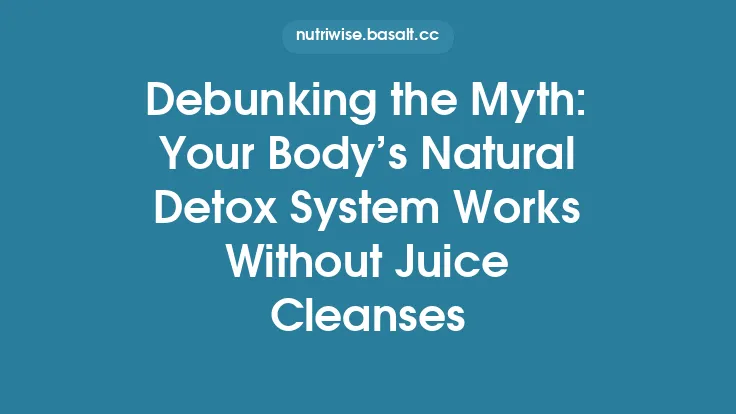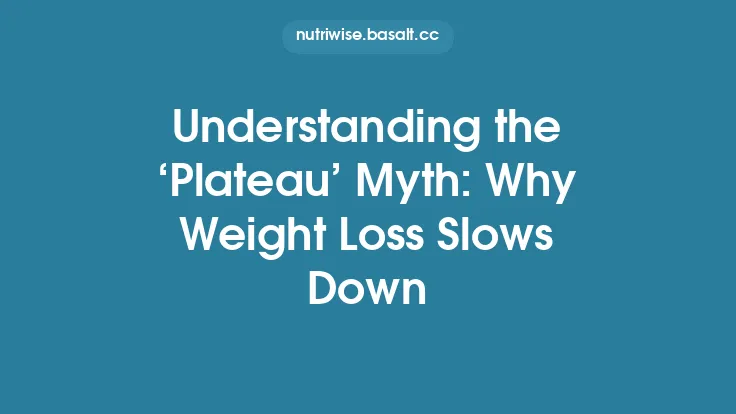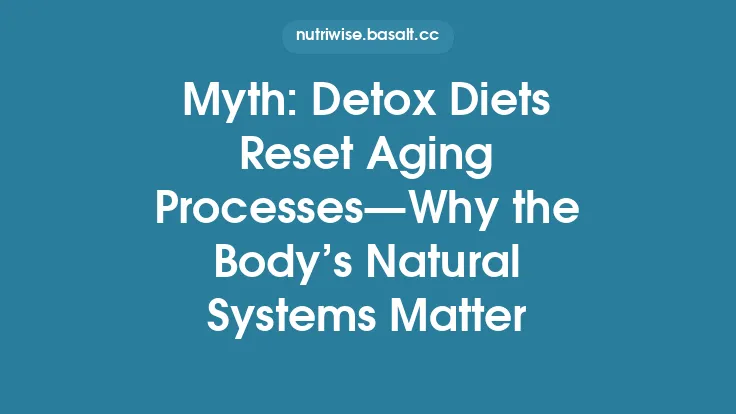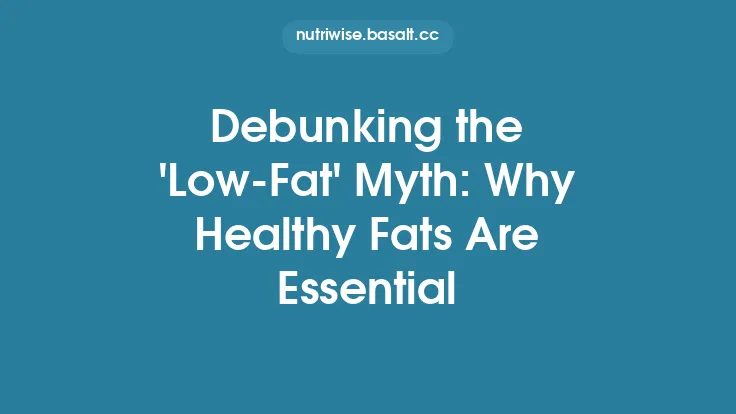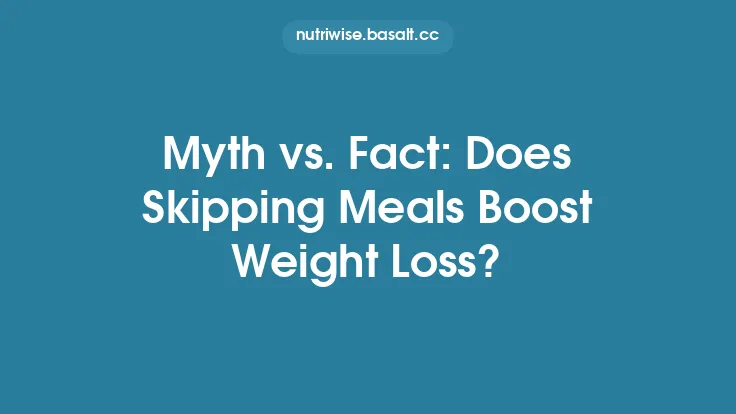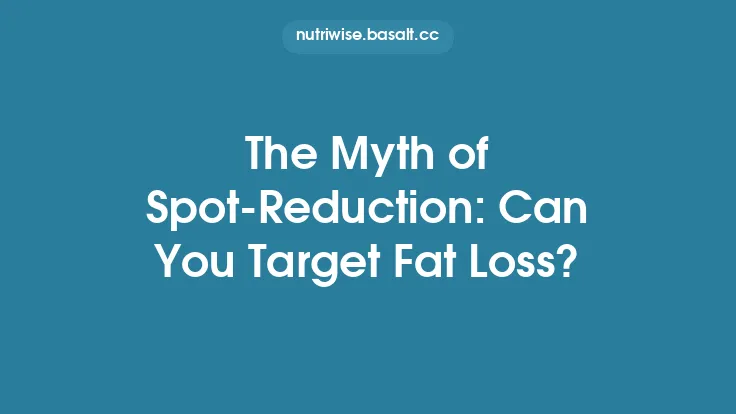The promise of a quick “detox” that melts away stubborn pounds is a staple of countless diet ads, social‑media posts, and wellness blogs. The idea is simple: ingest a special blend of juices, teas, or supplements, and your body will flush out toxins, reset metabolism, and shed excess weight almost effortlessly. Yet, despite its popularity, the detox‑for‑weight‑loss claim rests on shaky scientific ground. In this article we’ll unpack what “detox” really means, examine how the body naturally handles waste, explore why commercial detox programs rarely deliver lasting results, and outline evidence‑based practices that genuinely support healthy weight management.
What “Detox” Means in Popular Culture
- Marketing‑Driven Definitions
- “Detox” as a buzzword – Companies use the term to evoke a sense of cleansing, purity, and rapid transformation. It often implies that the body is overloaded with harmful substances that must be removed before weight can be lost.
- Typical product promises – “Cleanse your system,” “reset your metabolism,” “eliminate toxins,” and “lose up to X pounds in Y days.” These statements are deliberately vague, allowing marketers to avoid specifying which toxins are targeted or how they are measured.
- Common Formats
- Juice or broth fasts – Restricting solid food intake to low‑calorie liquids for several days.
- Herbal teas and supplements – Claimed to stimulate liver, kidney, or colon function.
- Colon cleanses – Enemas or laxatives marketed as “colon detoxes.”
- Detox kits – Bundles that combine diet plans, supplements, and sometimes “detox pads” or “detox patches.”
- The Implicit Weight‑Loss Narrative
- The rapid weight loss observed during many detoxes is usually due to caloric restriction, loss of water weight, and depletion of glycogen stores—not the removal of mysterious toxins.
The Body’s Natural Detoxification Systems
Your body is equipped with sophisticated, highly regulated mechanisms that continuously identify, transform, and eliminate waste products. These systems operate independently of any short‑term dietary regimen.
| System | Primary Organs | Key Processes | Typical End‑Products |
|---|---|---|---|
| Phase I Metabolism | Liver (cytochrome P450 enzymes) | Oxidation, reduction, hydrolysis of lipophilic compounds | Reactive intermediates (often more toxic) |
| Phase II Metabolism | Liver, intestines | Conjugation (glutathione, sulfate, glucuronide) to increase water solubility | Non‑reactive, water‑soluble metabolites |
| Renal Excretion | Kidneys | Filtration, secretion, reabsorption | Urine (urea, creatinine, water‑soluble metabolites) |
| Biliary Excretion | Liver, gallbladder | Secretion of conjugated metabolites into bile | Feces (bilirubin, cholesterol, drug metabolites) |
| Pulmonary Excretion | Lungs | Volatile compounds diffusing into exhaled air | Breath (acetone, ethanol) |
| Sweat Glands | Skin | Minor excretion of electrolytes, urea, lactate | Sweat (mostly water, salts) |
| Gut Microbiota | Large intestine | Fermentation, deconjugation, production of short‑chain fatty acids | SCFAs, gases, some metabolites excreted in stool |
These pathways are energy‑dependent and tightly regulated by hormones, nutrient status, and genetic factors. They do not require external “detox” products to function; rather, they thrive on adequate nutrition, hydration, and overall health.
Why Detox Diets Fail to Produce Sustainable Weight Loss
- Caloric Deficit, Not Toxin Removal
- Most detox programs drastically cut calories (often <800 kcal/day). The resulting weight loss is primarily energy deficit‑driven and largely consists of water, glycogen, and lean tissue. Once normal eating resumes, the body restores its energy balance, and weight returns.
- Metabolic Adaptations
- Prolonged low‑calorie intake triggers adaptive thermogenesis—the body reduces resting metabolic rate to conserve energy. This makes subsequent weight loss even harder and can lead to rebound weight gain.
- Loss of Muscle Mass
- Inadequate protein intake during detoxes can cause muscle catabolism. Since muscle tissue is metabolically active, its loss further lowers basal metabolic rate, undermining long‑term weight‑management goals.
- Lack of Evidence for Toxin Reduction
- Scientific studies measuring biomarkers of “toxins” (e.g., heavy metals, environmental pollutants) before and after short‑term detox regimens show no significant change beyond what occurs with normal dietary variation.
- Psychological Effects
- The restrictive nature of detoxes can foster an all‑or‑nothing mindset, leading to cycles of bingeing once the program ends. This pattern is counterproductive to sustainable, balanced eating habits.
Common Ingredients in Detox Products and Their Physiological Effects
| Ingredient | Claimed Action | Actual Physiological Effect |
|---|---|---|
| Caffeine / Green Tea Extract | Boosts metabolism, “burns fat” | Mild increase in thermogenesis; effect diminishes with tolerance; may cause jitteriness, insomnia |
| Dandelion (Taraxacum) Root | Diuretic, “flushing toxins” | Increases urine output, leading to temporary water loss; no impact on stored fat |
| Garcinia Cambogia | Suppresses appetite, blocks fat synthesis | Minimal effect on appetite; inhibition of fatty‑acid synthase is negligible in humans |
| Laxatives (senna, cascara) | “Cleanses colon” | Accelerates bowel movements, causing loss of water and electrolytes; does not affect systemic toxin load |
| Milk Thistle (Silymarin) | Liver “detoxifier” | Antioxidant properties; may support liver health in disease states, but no evidence of weight‑loss benefit |
| Apple Cider Vinegar | “Alkalizes body, burns fat” | May modestly improve satiety; acidic nature can erode tooth enamel if undiluted |
| Alfalfa Sprouts | “Detoxifies blood” | High in micronutrients; no specific detoxifying action beyond normal nutrition |
While many of these components are generally safe in moderate amounts, they can cause side effects (e.g., electrolyte imbalance, gastrointestinal distress) when consumed in the high doses typical of detox programs.
Potential Risks and Side Effects of Detox Regimens
- Nutrient Deficiencies – Prolonged restriction of whole foods can lead to insufficient intake of essential vitamins (B12, D), minerals (iron, calcium), and macronutrients (protein, essential fatty acids).
- Electrolyte Imbalance – Diuretics and laxatives increase loss of sodium, potassium, and magnesium, potentially causing arrhythmias, muscle cramps, or fainting.
- Gastrointestinal Disturbances – Rapid changes in fiber intake can provoke bloating, constipation, or diarrhea.
- Hormonal Disruption – Severe caloric restriction can affect thyroid hormones, cortisol, and reproductive hormones, leading to menstrual irregularities or reduced fertility.
- Psychological Impact – The promise of a “quick fix” may reinforce unhealthy relationships with food and body image, increasing the risk of disordered eating patterns.
Evidence‑Based Strategies for Healthy Weight Management
- Balanced Energy Intake
- Aim for a modest caloric deficit (≈10–20% below maintenance) to promote steady fat loss while preserving lean mass.
- Adequate Protein
- Consume 1.2–1.6 g of protein per kilogram of body weight daily to support muscle maintenance and satiety.
- Whole‑Food Emphasis
- Prioritize vegetables, fruits, whole grains, lean proteins, and healthy fats. These foods provide fiber, micronutrients, and phytochemicals that naturally support liver and kidney function.
- Regular Physical Activity
- Combine resistance training (2–3 sessions/week) with aerobic exercise to increase total energy expenditure and preserve muscle mass.
- Hydration
- Adequate water intake facilitates renal excretion and helps maintain optimal blood volume for metabolic processes.
- Sleep and Stress Management
- Quality sleep (7–9 hours) and stress‑reduction techniques (mindfulness, yoga) regulate hormones that influence appetite and fat storage.
- Mindful Eating Practices
- Paying attention to hunger cues, eating slowly, and avoiding distractions can reduce overeating without the need for extreme restrictions.
These approaches work synergistically with the body’s innate detox pathways, ensuring that waste products are efficiently processed while supporting a sustainable, health‑focused weight trajectory.
How to Support Your Body’s Natural Detox Pathways
- Consume Antioxidant‑Rich Foods – Berries, leafy greens, nuts, and seeds supply vitamins C and E, polyphenols, and flavonoids that protect liver cells from oxidative stress.
- Include Fiber‑Rich Sources – Soluble fiber (oats, legumes, psyllium) binds bile acids and certain toxins, promoting their excretion via feces.
- Maintain a Healthy Gut Microbiome – Fermented foods (yogurt, kefir, kimchi) and prebiotic fibers foster beneficial bacteria that assist in metabolizing xenobiotics.
- Limit Alcohol and Processed Additives – Excess alcohol overwhelms hepatic enzymes; artificial preservatives can increase the detox burden.
- Stay Physically Active – Exercise enhances circulation, supporting the transport of metabolites to excretory organs.
- Ensure Sufficient Micronutrients – Selenium, zinc, and B‑vitamins are cofactors for detoxification enzymes; a varied diet typically meets these needs.
By focusing on overall nutritional adequacy and lifestyle habits, you empower the body’s built‑in systems to perform their detox functions efficiently—without the need for costly, restrictive “detox” products.
Conclusion: Separating Fact from Fiction
The allure of a detox that simultaneously “cleanses” the body and melts away pounds is understandable in a culture that prizes quick fixes. However, the scientific consensus is clear:
- Your liver, kidneys, lungs, skin, and gut already handle detoxification continuously and effectively when supplied with proper nutrients and hydration.
- Weight loss observed during detox programs is primarily a result of caloric restriction and water loss, not the elimination of mysterious toxins.
- Short‑term detox regimens can pose health risks—nutrient deficiencies, electrolyte disturbances, and metabolic slowdown—especially when repeated or prolonged.
- Sustainable weight management is best achieved through balanced nutrition, regular physical activity, adequate sleep, and stress control—strategies that also support the body’s natural waste‑processing pathways.
Instead of chasing the myth of a magical detox, focus on building a resilient, well‑nourished body. When you do, the “detox” you need happens automatically, and any weight loss you experience will be the result of genuine, health‑promoting changes rather than a fleeting fad.
